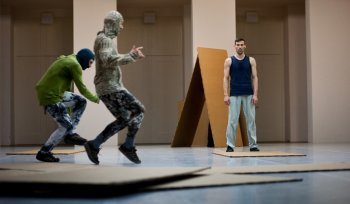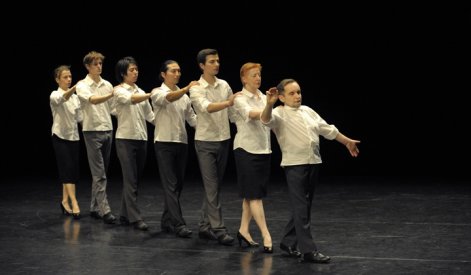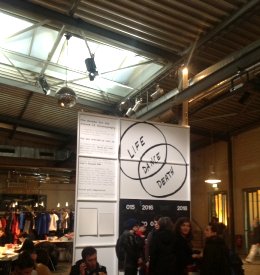
|   |

|   |
Tanzplatform 2014 - Life, Death & Dance - Madhu Nataraj e-mail: stemdance@hotmail.com April 23, 2014 For a busy performer like me, the opportunity to take time out and immerse myself in Dance in the capacity of an audience, a mere bystander even, for five whole days feels like a rare self indulgence. I did manage to squeeze in those few days to attend Tanzplatform or the German Dance Platform 2014 during a supremely hectic time in my life and feel greatly inspired and invigorated from the experience. At the behest of Goethe Institute Bangalore and New Delhi, I was invited to be a guest observer to attend one of Germany’s most coveted dance festivals, which travels as a Biennale to different host cities. The host city this time was Hamburg and the venue was Kampnagel, a 10,000 sq feet erstwhile shipping warehouse converted into the city’s hub for dance, theatre and music. A meeting with Amelie Deuflhard, Artistic Director of Kampnagel, revealed that the space is kept busy through the year with festivals, workshops and residencies in the genres of Opera, Jazz, theatre and contemporary dance.  Photo: Dominik Mentzos The opening night featured one of the dance world’s most acclaimed choreographers- William Forsythe. The Forsythe Company presented its new work ‘Sider’. Dancers carrying 7 by 4 ft wooden boards created dramatic moments and formations. Interestingly, Sider had a concealed soundtrack of a 16th century tragedy, which only the dancers could hear through their ear pieces! Forsythe’s principle of reorienting the practice of ballet to a modern phenomena was apparent. Gibberish monologues combined with spoofy theatrics, profound dramaturgy and some outstanding dancing created a strong mosaic imagery. During the day, the Kampnagel foyer came alive with talks and discussions on subjects like ‘the future of dance’. I recall a particularly heated debate where the audience members attacked the panelists who represented the jury responsible for the festival content. 12 of the most promising productions from the last 2 years were presented at Kampnagel which also created opportunities for newer artistes to share their work and network for future possibilities. One such insightful exchange was called ‘Pitches’, where performers offered a glimpse into their philosophy and the work that they intended to present if chosen for future Tanzplatforms. Two very diverse artistes sharing remains embedded in my mind. One was a woman who is committed to continuing the legacy of Contemporary Dance in a country (I choose not to mention the country or the dancer), which has banned dance. For me personally, it was almost heart wrenching watching dancers secretly meeting in a society which considers dance a subversive activity. A poignant juxtaposition of victimization and bravery. The other was an American choreographer who offered ‘cleaning’ services in the public domain. Utilizing dance as a function, he swept and mopped an area clean while demonstrating his choreography which included motifs of street, hip hop and modern dance! ‘Black Swan’ by Richard Siegal looked at interdisciplinary possibilities both for the research and execution of a performance. This performance art work was not very well received, but I loved it. Text, distorted vocal renditions and video images collided with minimal movements of the soloist who was always in partial darkness creating a mystical almost shamanistic effect on stage.  Richard Siegal in' Black Swan' Photo: Franz Kimmel  Isabelle Schaud in 'Der Bau' Photo: Laurent Goldring Laurent Chetouane’s work, 15 Variations, much to my surprise, got over half a dozen curtain calls. But then he is an institutionalized figure in the modern performance arts scenario. Isabelle Schad’s solo ‘Der Bau’ was refreshing in its simplicity. Isabelle was naked and interacted with 3 fabrics of different textures and volume creating a visual soundscape while morphing into shapes and imagined beings. The audience could actually witness the physiological transformation of her ‘Danced body’. Meg Stuart’s ‘Built to Last’ centered on unusual reactions to classical western music of epic composers. This was clearly a festival favorite for most spectators. ‘Dansereye’ by Sebastian Matthias was a treat for the senses. It followed an interactive format where performers and the audience shared spaces and roles. We were given bracelets with bells on them and were free to ‘create’ our own intentional and often unintentional sound scores. A live music ensemble fashioned like a live club band created an atmosphere of a social gathering as 4 wonderfully trained dancers wove their way through the audience, sometimes becoming the viewers as the audience ‘danced’! ‘The Factory’ by Swoosh Lieu tested my patience and tolerance. A part of Kampnagel was transformed into a factory like atmosphere. The audience waited outside the ‘factory’ door where a black & white film of factory workers leaving after work was projected. The audience was asked to move from one part to the other while being subjected to dancers working on machines, vehicles and other industrial paraphernalia. Tino Sehgal’s ‘Untitled’ had a nude soloist offering glimpses of dance history and of course his anatomy ending with him urinating on stage. Some people love this work… not me! Antonia Baehr’s ‘Abecedarium Bestiarium’ was a retelling of experiences, incidents and facts where she used devices of impersonation, disguises and sound to become the story. A very engaging work indeed.  Raimund Hogue in ‘Cantatas’ Photo: Rosa Frank The final performance of the festival featured Raimund Hogue, the late Pina Baush’s close associate and dramaturge. ‘Cantatas’ was clearly my take away piece from the festival. A solid 3-hour dance theatre piece which waded through memories, ritual, mortality, nostalgia and sensuality among other aspects. Hogue’s signature dance theatre style this time was a blend and collision of Bach, opera ( sung live at times), old Hollywood soundtracks, Japanese dance, and the spoken word invoking an ethereal stillness. ‘Cantatas’ drew extreme reactions from the audience. Some found it too long or termed the style 'a Pina hangover' whereas some others connected to its simplicity and organic quality.  Festival foyer Photo: Madhu Nataraj In the foyer, Tanzplatforms’s spirit could be summarized through its thematic hoarding which was a Venn diagram displaying the words Life, Death & its common denominator- Dance! Rings true for me too! Madhu Nataraj is an exponent of Kathak & Contemporary Indian dance. She is the artistic director of STEM Dance Kampni, Bangalore. |